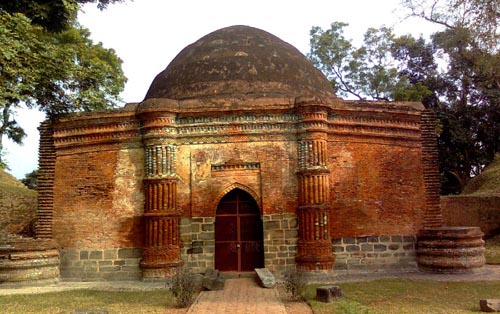Gumti Gate

Information on Gumti Gate (Malda, West Bengal) - History & Architecture
Gumti Gate was the eastern gateway to the fortress of Gaur in Malda of West Bengal. Gaur was regarded as the capital of Sultans during the period of 13th to 16th century. This gateway was used as a small gateway to enter Gaur and at present, it stands only as a brick structure. However, the remains of the gateway is still quite beautiful and impressive. Its historical importance is well recognised, though it is less taken care by the authority and the concerned department.
Gumti Gate Architecture
The construction of Gumti Gate is marked by Mughal architectural style. Gumti Gateway consist of a brick made room with 7.60 square meter wall. The exterior of the building has four entrances. The east and west entrance is bordered by lined turrets and at every corners of the building there are towers. On every side of the entrances, there are pleated columns of stonework and a building, having decorated cornice. The structure of Gumti Gate is covered by a single roof, which was created on squinches, a feature which begin with the creation of Eklakhi Tomb. The gateway has certain link with the Gaur fort wall at the north and south side of the building. Gumti Gateway also has as fixed cornice which was decorated by tiles, rather than normal terracotta techniques. The flutes of Gumti Gate suggest significant influence of Adina Mosque.
Gumti Gate History
The time of the construction of Gumti Gate is quite unclear. Some researchers believe that it was created by Sultan Nais-ud-din Mahumud Shah during the period of 1442 AD to 1459 AD. On the other hand, others, according to the indication of label found in Niamatullah compound, believe that Gumti Gate was founded throughout the sovereignty of Sultan Ala-ud-din Hussain Shah in the year 1512 AD. Thus it is very difficult to trace down when this historical and majestic gateway came into existence, though time and again its historical importance are talked about.
It has been argued that since Gumti Gate is decorated with tiles and since the construction of the gateway has certain features which was used during the era of Husain Shahi, the building should be the work of Sultan Ala-id-din Husain Shah. However, this argument can also be considered as unsound due to the reason that the present remnants of tiles used in Gumti Gate was built about one century earlier and continued to be used through every houses who ruled in Gaur. Furthermore, if there remains a royal entrance from north for Gaur, there would have been other secondary or alternative entrance on other sides. Thus, from historical evidence, the creation of Gumti Gate is still vague and it continues even though efforts are been made to find out the real construction of the gateway and the time when it come to existence. Though from historical point of view, its importance is well known even today, but when and how and at whose rule it was built remains mystery for many archaeologists.
Gumti Gate Tourism Importance
Gumti Gate is regarded as a unique piece of historical architecture. The building is quite majestic and its interior and exterior design can attract the travellers. Based on Muslim architectural style, Gumti Gate is regarded as a significant Islamic memorial of West Bengal. Its design is quite fabulous and can be regarded as a vital place for tourism. By visiting Gumti Gate, tourist can enjoy the impressive brick work of Sultans during the 13th century.
- Andaman Nicobar Monuments
- Andhra Pradesh Monuments
- Assam Monuments
- Bihar Monuments
- Chhattisgarh Monuments
- New Delhi Monuments
- Goa Monuments
- Gujarat Monuments
- Haryana Monuments
- Himachal Pradesh Monuments
- Jammu and Kashmir Monuments
- Karnataka Monuments
- Kerala Monuments
- Madhya Pradesh Monuments
- Maharashtra Monuments
- Odisha Monuments
- Punjab Monuments
- Rajasthan Monuments
- Tamil Nadu Monuments
- Telangana Monuments
- Uttar Pradesh Monuments
- West Bengal Monuments